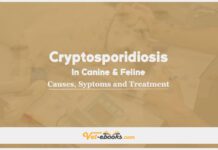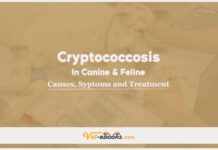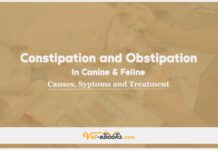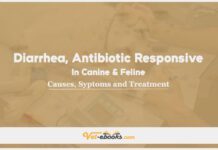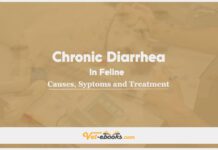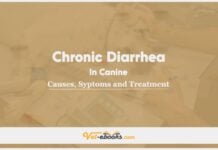Flatulence In Canine and Feline: Causes, Symptoms and Treatment
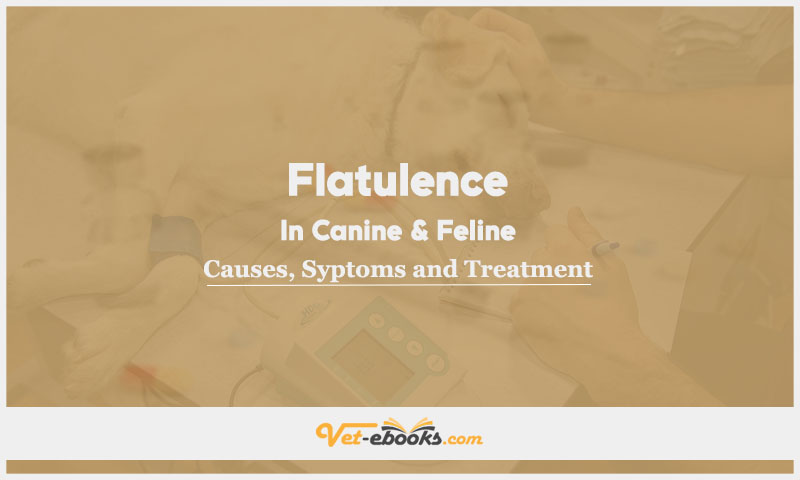
Overview
- Physiological process of eliminating gases produced within the GI tract by means of the anal opening.
- The term “flatus” is used to describe the presence of gas that is produced within the gastrointestinal tract.
Causes of Flatulence In Canine and Feline
Causes
Aerophagia
- Gluttony and competitive eating.
- Respiratory disease or any factor leading to an elevated respiratory rate or higher respiratory effort.
- Brachycephalic breeds.
Diet-Related
- Diets rich in nonabsorbable oligosaccharides (soybeans, peas, and beans).
- Diets rich in fermentable fiber (pectin, gums, carrageenan, inulin, psyllium, and oat bran).
- Perishable food items that undergo spoilage.
- Dairy products.
- Abrupt alterations in dietary patterns.
Disease Conditions
- Acute and chronic intestinal diseases (protein-losing enteropathies, intestinal dysbiosis, neoplasia, irritable bowel syndrome, parasitism, bacterial, protozoal, or viral enteritis, and food allergy or intolerance).
- EPI.
Risk factors
- Brachycephalic breeds.
- Large-breed dogs.
- Nervousness, gluttony, and competitive eating.
- Consuming food shortly after physical exercise.
- Sudden alterations in food patterns.
- Consumption of unsuitable or deteriorated dietary items.
- Absence of consistent physical activity.
Pathogenesis of Flatulence In Canine and Feline
- The act of expelling flatus is a regular physiological process.
- Differences in the size, smell, and occurrence rate of flatulence may lead the owner to consider the emission of gas as an issue.
- Aerophagia, fermentation of nutrients by bacteria, interaction between stomach acid and pancreatic or salivary bicarbonate, and movement of gases from the bloodstream are the main sources of gas in the digestive tract.
- The majority of gases found in the gastrointestinal tract are odorless, constituting almost 99% of the total, consisting of nitrogen, oxygen, hydrogen, carbon dioxide, and methane.
- The gastrointestinal gases consist of a small proportion, less than 1%, of malodorous gases that contain volatile sulfur compounds.
- These substances include ammonia, hydrogen sulfide, methanethiol, dimethylsulfide, indole, skatole, volatile amines, and short-chain fatty acids.
- Dogs and cats do not possess the necessary digestive enzymes to break down oligosaccharides, which are derived from vegetables, into monosaccharides that may be absorbed by their bodies.
- The microbiota in the colon uses foods with a high oligosaccharide content as fuel, which results in excessive gas production.
- Foods containing fermentable fibers, including pectins, gums, and carrageenan, directly contribute to the production of flatus through the process of fermentation by the colonic microbiota.
- Dogs and cats cannot handle lactose, which means that if they eat 1.5 g/kg/day of lactose in their food, which is about 11 g of lactose in 1 cup of milk, they can get symptoms like gas and diarrhea.
- The augmented volume or odor of flatus is frequently attributed to hypersensitivity or intolerance towards specific proteins or carbs.
- Protein-losing enteropathies (PLEs) and EPI are diseases that make it hard for the body to absorb nutrients. This can make nutrients available for fermentation in the colon, which causes more gas.
- Specific enteropathogenic microorganisms (Giardia) result in an elevation in flatulence levels.
- Antibiotics that change the makeup of the microbiota in the gut may make intestinal gas worse.
Symptoms (History & Physical Examination) of Flatulence In Canine and Feline
History
- The phrase “He who smelt it dealt it” refers to the behavior of a pet that often turns its head to sniff or inspect its posterior region.
- Increase in frequency, volume, or unpleasant smell of the pet’s flatus emissions.
- When there is excessive flatulence, it can be attributed to pancreatic or gastrointestinal diseases.
- Additional gastrointestinal symptoms may be observed (diarrhea, vomiting, borborygmus, changes in appetite, and weight loss).
Physical Examination
- May be normal.
- Gastrointestinal gas distention can lead to abdominal discomfort.
- When examining the abdomen, an increase in borborygmus or a reduction in gut sounds may indicate the presence of ileus.
- A low body condition score may serve as an indicator of potential pancreatic insufficiency or gastrointestinal disorders.
- Obesity indicates a predominantly inactive lifestyle or excessive consumption of food.
- Aerophagia causes excessive flatulence, which comes with respiratory symptoms like excessive panting, increased noises in the upper or lower airways, difficulty breathing, and rapid breathing.
Diagnosis of Flatulence In Canine and Feline
1- From History and Physical Examination
2- Diagnostic Procedures
CBC/BIOCHEMISTRY/URINALYSIS
Typically, a standard minimal database is employed unless there is a notable presence of intestinal disease, such as hypoalbuminemia in protein-losing enteropathy (PLE).
OTHER LABORATORY TESTS
- Rectal cytology to assess neoplasia, parasites, and fungal pathogens.
- For giardiasis, zinc sulfate flotation tests, fecal ELISA tests, or PCR methods.
- Fecal PCR to detect Tritrichomonas in juvenile felines or kittens.
- Fecal cultures or PCR to assess salmonellosis or campylobacteriosis.
- Serum trypsin-like immunoreactivity to assess EPI.
- Serum cobalamin and folate concentrations as diagnostic markers to assess severe small-intestine illness.
Imaging
- Abdominal radiographs exhibit no significant findings or demonstrate dilated small intestines filled with gas.
- Abdominal ultrasonography to identify gastrointestinal masses or mural thickness.
- In certain cases, it is necessary to conduct contrast tests to identify an obstructive pattern.
- The evaluation of gastrointestinal motility poses challenges, yet certain referral centers employ scintigraphic markers for this purpose.
- The utilization of barium in an upper GI series to identify instances of delayed gastric or intestinal emptying.
- The results of this diagnostic procedure may exhibit significant variability due to the influence of stress factors.
Additional Diagnostic Tests
Gastrointestinal biopsy specimens are collected during surgical procedures or through endoscopy to identify and diagnose infiltrative gastrointestinal diseases.
3- Differential Diagnosis
- Increased aerophagia.
- Nutritional influences.
- Motility abnormalities.
- Malabsorption.
- Alterations in the intestinal flora.
- Discriminate between dietary and behavioral factors contributing to flatulence in gastrointestinal disorders through a comprehensive assessment of the patient’s medical history.
- This enables the healthcare provider to determine the specific dietary patterns, quantity of food consumed, frequency of meals, changes or additions to the diet, feeding environment, and exercise frequency.
Treatment of Flatulence In Canine and Feline
General:
The objective of therapeutic intervention is to reduce the occurrence of flatulence and enhance the overall comfort of the patient, recognizing the potential limitations in achieving complete eradication of flatulence.
Medications:
- Carminatives (pharmacological agents that alleviate flatulence) do not provide evidence about the safety or efficacy of these treatments in canines or felines.
- Zinc acetate exhibits an affinity for sulfhydryl molecules, leading to their binding.
- Yucca schidigera binds ammonia, making it a suitable additive in pet feeds to enhance flavor.
- Dry-activated charcoal absorbs nearly all odorous gases when combined with human feces and flatus. However, it does not lead to a decrease in the frequency of flatus occurrences, the amount of gas expelled, or the intensity of odor.
- When activated charcoal, Yucca schidigera, and zinc acetate were added, the number of bad smell episodes in dogs went down.
- Bismuth subsalicylate, orally to dogs at an initial dosage of 1 mL/kg followed by subsequent dosages of 0.25 mL/kg every 6 hours, adsorbs hydrogen sulfide and possesses antibacterial properties.
- The impracticality of its long-term and frequent administration limits its practical application.
- In felines, it is not advised due to its tendency to cause salicylate poisoning.
- Simethicone (antifoaming agent) diminishes the surface tension of gas bubbles, facilitating their coalescence and escape from the gastrointestinal tract.
- Simethicone does not affect the formation of gas.
- Pancreatic enzyme supplements reduce flatulence symptoms in patients who experience diminished pancreatic enzyme production.
Some Notes:
Avoid administering bismuth subsalicylate to patients who have gastroduodenal ulcers and bleeding disorders.
Do You Want To Increase Your Veterinary Knowledge and Practical Skills?
You Can Now Browse and Download +3000 Books For Veterinary Professionals & Students Online.
Download Veterinary Books

